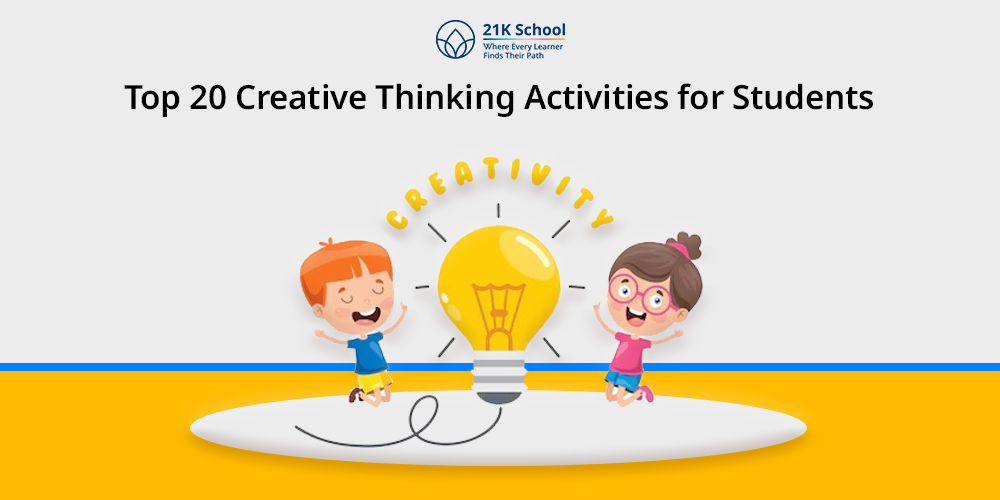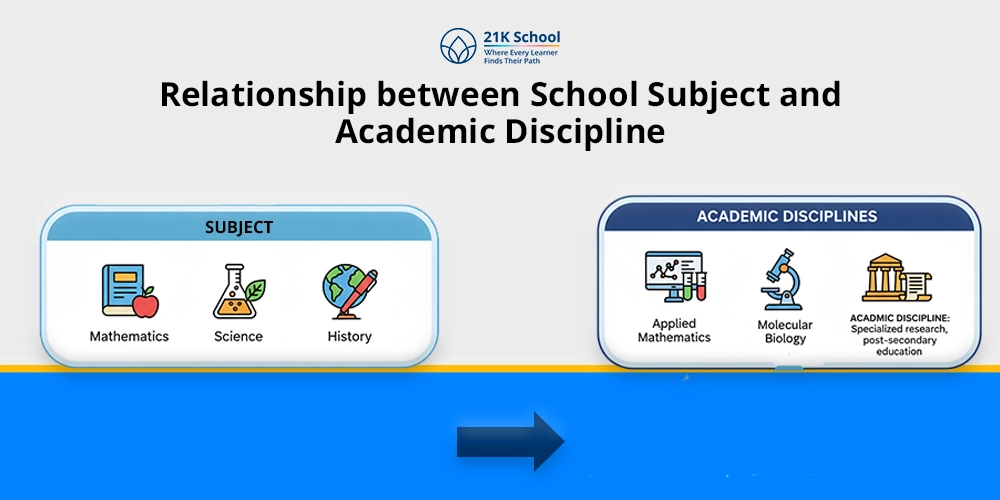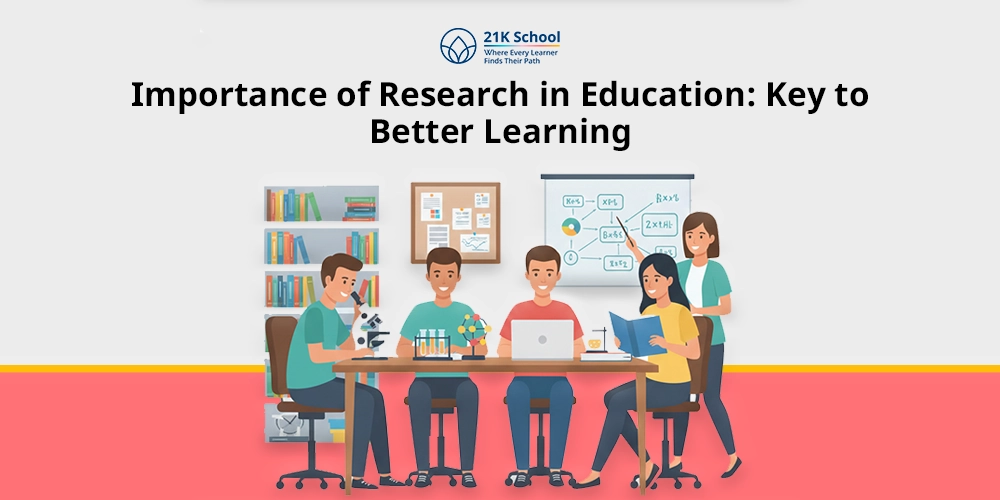
Do you think that learning in kids can only happen with textbooks?
If you do really think so, you might be wrong because the world has always been generous to learners who were creative and wanted to explore things around them.
You might have seen small students painting and creating something of their own like a sky as pink instead of blue.
And when they are asked why they did so they would create their own story from their memories and understanding which sometimes actually stuns or mesmerizes the elders.
The following are the 20 creative thinking activities for students which they might learn from and grow as unique personalities in near future.
Contents
- What are Creative Thinking Activities for Students?
- 20 Creative Thinking Activities for Students
- 1.Brainstorming
- 2. Incomplete Figure/Drawing
- 3. Art and Craft
- 4. Role Playing
- 5. Building Blocks
- 6. Dance
- 7. Play the What If Game
- 8. Bath Paint
- 9. Crafting Puppet
- 10. Mind Mapping
- 11. Classifying and Sorting
- 12. Debates
- 13. How Many Uses
- 14. Logo Makeover
- 15. Create a New Word
- 16. Invent a New Animal
- 17. Music as Art Prompt
- 18. Describing with Adjectives
- 19. Storytelling the Pixar Way
- 20. Puzzles
- Wrap It Up
What are Creative Thinking Activities for Students?
Students especially who are still young enjoy learning beyond syllabus and textbooks. Creative thinking activities exercised by these students bring a sense of critical thinking pushing them to look ahead of rote learning .
When kids are given situations where they have free will to draw, create, and think beyond, without any fear, they show a deeper understanding of how their world looks.
It can be truly encouraging for each kid and bring a twisted sense of fun in learning .
To execute these tasks and exercises in present school settings, educators can start with providing opportunities for asking questions, giving context like “what if’s” and many others which can or cannot be associated with individual subjects taught in the class.
Now, let’s see how some of these creative thinking activities can be performed in groups and as individuals in a detailed way.
20 Creative Thinking Activities for Students
If you are wondering what kind of activities you should ask your students to perform as classroom activities and teach creative thinking skills, the following section might make your search end here.
1.Brainstorming
Brainstorming simply is to ask questions to kids about anything related or non-related to their syllabus and then welcoming ideas without judgement. These opportunities instil participation and speaking abilities in small children.
- Materials Required: Maybe some blank cards to pass on after writing ideas, or nothing.
- How to Do it: The easiest process of brainstorming is to write a topic that needs discussion and interests children. Then, asking them to write small rapid ideas in the small cards, or simply just speak their minds without fear of being judged.
- Pro tips: Encourage ideas, even the ones that might sound weird at first but might lead to somewhere having real depth of understanding.
2. Incomplete Figure/Drawing
You might have seen small kids textbooks where they are given half apple, or sometimes just a half alphabet. Students complete these diagrams and figures from their own analytical skills and imagination.
- Materials Required: A chart paper with incomplete drawing, pencils, colours, etc.
- How to Do It: Simply give children a sheet of paper with half drawing and ask them to complete it by making something from the imagination.
- Pro Tips: Support students’ visual learning routine and encourage them to develop things they can imagine from the given lines.
3. Art and Craft
Art and Craft activities really give a new diversion to the imaginative thinking patterns of children. This is even better because it involves tactile sensations of learners and they learn better from the textures utilized from different materials.
- Materials Required: Crayons, colorful chart papers, ice sticks, matchsticks, glue, clay, and many other materials.
- How to Do It: First decide on what you want to give students to make like a small ice stick boat, pen stands, leaf-pattern butterflies or something else. Then provide them with the prerequisites and be patient while they unfold their creative magicians inside them.
- Pro Tips: Whenever you feel like students need assistance like in paper cutting, or using glue, or others, help them.
Refer to some more creative art and craft ideas for kids .
4. Role Playing
The role playing activities are kids favourite as they also play them with their friends and siblings when at home. This helps in judging their imaginary skills and observation skills of the outside world.
- Materials Required: All the things used by the character they need to perform the role of. For example, the role of a doctor might require specs, toy stethoscope, injections, medicines, etc.
- How to Do It: Now students can be asked to perform like a doctor they visited and show everyone how they behaved and treated them.
- Pro Tips: Pause and ask the student why he/she did certain acts in the role playing and what it means to them.
5. Building Blocks
Building blocks is one of the best activities to build storytelling for learning and cognitive development of children .
- Materials Required: Wooden blocks, magnetic tiles, LEGO are some best options for executing building blocks activity.
- How to Do It: Ask a group of kids to join in and form a city or building or a house of their own choice from the blocks provided, thus carefully adjusting the blocks to manipulate the shape of their project.
- Pro Tips: Allow them to freely think and portray their understanding and explore their imaginations.
6. Dance
Dance is itself a form of expression and self-exploration, which is why it gives the opportunity to students to acquire positive thoughts in their minds.
- Materials Required: An open space, music system, and props (Optional).
- How to Do It: Ask kids to perform in solo or in pairs after the music is played. Tell them not to worry about judgement and that they will be really good.
- Pro Tips: You can tell young kids to write their experiences and feelings after performing dance activities.
7. Play the What If Game
If you are really trying to explore the imaginary capabilities of your school going children, shoot them with this game of “What if”. Let them travel through their hypothetical thoughts and get an answer.
- Materials Required: Cards with questions on them starting from “what if”, and a bowl.
- How to Do It: Keep a bowl of cards where questions are mentioned, and ask students to come up and pick one card. They will then loudly read out the question to the class. Here for example, “what if this earth was flat?”. Now welcome ideas from each student and notice how their ship of imagination and critical thinking sails.
- Pro Tips: Let your judgement be silent in such discussions.
8. Bath Paint
An episode of messy play that curates kids’ visual thinking routine , can be possible with bath paints.
- Materials Required: Wipeable paints (you can also make it by mixing shaving cream and food colouring), bathroom.
- How to Do It: Your toddler needs a big space. Then your kids can draw whatever they feel like on the surface.
- Pro Tips: Go deeper with the abstract arts they made. Your kids don’t eat the paints as it is inedible.
9. Crafting Puppet
Students of slightly mature age can craft puppets. If making puppets of their own choice, naming them, creating stories around them, enjoy and boost their creativity.
- Materials Required: Need glue, ice sticks, paints, scissors, etc.
- How to Do It: Give all the requested items from their choice of puppets making. Once the puppets are made, name the characters and tell a story about those characters.
- Pro Tips: You can also allow students to form groups to develop team-management and storytelling skills.
10. Mind Mapping
Mind mapping requires a central topic around which branches are drawn meeting an empty blank or box. Children are given the opportunity to excel their divergent thinking abilities.
- Materials Required: A board, or blank sheet of paper, colours, pencils.
- How to Do It: First of all, if you are an educator in the class, you can draw something like a box in the centre of the paper and write “family” in it. Now extend branches from there and stop at the small boxes to join both. At last, ask students to come up and fill the boxes based on the thing written in the central box.
- Pro Tips: Ask the learners the reason to write words they wrote in respective boxes.
11. Classifying and Sorting
Children from a tender age enjoy the task of classifying and sorting, because it keeps their attention at one place and builds problem solving techniques in them.
- Materials Required: Sensory bins, pompoms, colorful stones, etc.
- How to Do It: Provide any of the above mentioned items and tell students to either sort items by size or by colour.
- Pro Tips: Give different students different classifying criterias.
12. Debates
Debates can be proven to be another fun learning activity to support the views and ideas of kids and enhance their speaking and critical thinking skills .
- Materials Required: Topic ideas
- How to Do it: Provide a topic based on the age and learning potential of learners. Then, move on to forming a random group and divide them into two teams speaking for or against the topic.
- ProTips: Give topics to students that actually interest them.
13. How Many Uses
This might sound interesting to you too as finding multiple uses of common items is challenging yet fun.
- Materials Required: Any object from the surroundings like a bottle, chalk, stick, etc. (These are just for reference, you don’t actually need to have them)
- How to Do it: Point at or bring any object from the learning environment and tell how many possible uses you can think of by looking at this item. Give 5-10 minutes to brainstorm and then ask serially to each one.
- ProTips: Reward the student who gave the most novel answer.
14. Logo Makeover
Logo makeover depicts redesigning of popular logos with a twist. This offers space to visual learning and builds relatedness of more than one subject at a time in children.
- Materials Required: Real printed logos, colours, pencils, erasers, or designing apps like Canva.
- How to Do it: Give reference pictures or real printed logos of famous brands like starbucks, etc. Add a twist for redesigning like you have to make this Starbucks logo, but for a kids’ toy brand. See the results and see the detailed elements they put in.
- ProTips: Ask about the details they bring the logos and appreciate the best logos with small prizes.
15. Create a New Word
New word formation might seem a bit challenging but will surely be worth doing it. It can also be included in creative english activities for kids enhancing their fluency and understanding of etymology.
- Materials Required: Pen and Paper
- How to Do it: Students would like freedom to think and then share their created words, so give them that. Also encourage them to define their words however they might understand better and then tell them to form sentences with the words.
- ProTips: Don’t underestimate the potential of these kids and try to build stories of evolution around the words created.
16. Invent a New Animal
Kids are seen to draw different kinds of animals when given to draw or paint. Inventing a new animal based on their personal understanding of animals can encourage creativity and out of the box thoughts.
- Materials Required: Drawing items, or clay.
- How to Do it: Teachers can give a theme like desert, ocean, or others and tell students to draw an animal that they think can live in such conditions. Students can also complete their naming part.
- ProTips: Mindfully check what features they included in their imaginary animals and inquire about the why.
17. Music as Art Prompt
Emotional intelligence is linked with good music. When you utilize music for pushing your artistic self to perform, it does wonders.
- Materials Required: Sound system, paints and brushes.
- How to Do it: Begin by playing music and asking students to listen to music. You can then proceed with telling them to draw anything to represent how they might be feeling inside.
- ProTips: Notice each stroke of the students’ painting and settle them up for other social emotional learning plans.
18. Describing with Adjectives
The adjectives used for a particular thing, living, being, or anything get into detail to describe a part of it which is only possible due to creative thinking.
- Materials Required: Images or pictures you kids might want to describe,pen and paper.
- How to Do it: The process includes telling your learners to write at least 15-20 adjectives by seeing the picture of a bird, tree, or anything. The next step is to create a paragraph or a poem with those words.
- ProTips: Read out the best poems in the class.
19. Storytelling the Pixar Way
Storytelling has been the most historical method of conveying ideas. The Pixar way can offer the story an opening, middle part and then the end with your creativity.
- Materials Required: A sheet of paper and pen to write a story.
- How to Do it: Motivate students to write their stories starting with “once upon a time…”, then with “Everyday…” and finally about the climax as “one day…”.
- ProTips: These divisions in thoughts as parts for constructing stories can make the task seem easier to kids.
20. Puzzles
Children always seem interested in solving puzzles and can do such things in class as well. As educators, you can help them and ask their parents to see progress in their cognitive thinking skills.
- Materials Required: Puzzle board
- How to Do it: Divide students into groups and guide them to take the reference picture as their targets. They will slowly arrange every piece of the puzzle in place and feel a sense of achievement.
- ProTips: Don’t force outcomes and give enough time to children.
Wrap It Up
You are well aware of many activities that can bring creative thinking abilities in your young students and fun in learning. The involvement of parents can fasten the process of acquiring such crucial in children, as they will get guidance in the home too.
Every task or exercise has a different target audience. As kids enjoy learning through these activities, they should be incorporated into present school activities from a young age to build critical analysis, imaginative play, motivation, problem solving and confidence.
Practice all these activities in your classrooms and make your teaching methods unique now.


